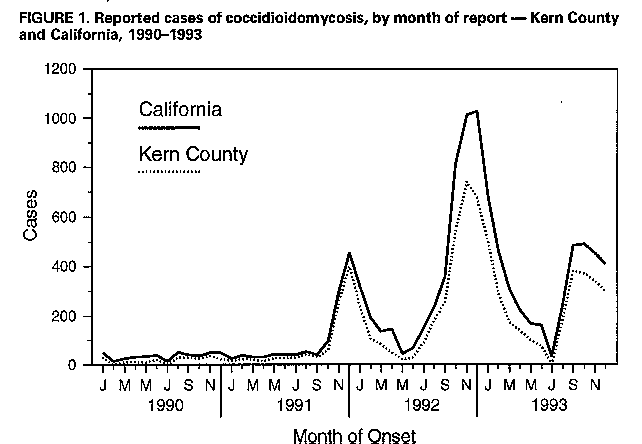 |
|
|
|
|
|
|
| ||||||||||
|
|
|
|
|
|
|
||||
| ||||||||||
|
|
|
|
|
Persons using assistive technology might not be able to fully access information in this file. For assistance, please send e-mail to: mmwrq@cdc.gov. Type 508 Accommodation and the title of the report in the subject line of e-mail. Coccidioidomycosis -- California, 1991-1993Coccidioidomycosis is an infection caused by the fungus Coccidioides immitis, which resides in the soil in some areas of Arizona, California, Nevada, New Mexico, Texas, and Utah. Infection can occur when airborne, infective arthroconidia are inhaled. Symptomatic coccidioidomycosis, which occurs in approximately 40% of all infections, has a wide clinical spectrum, including mild influenza-like illness, severe pneumonia, and disseminated disease. Beginning in 1991, the number of cases of coccidioidomycosis reported annually to the California Department of Health Services (CDHS) increased dramatically (1) (Figure_1). This report summarizes the occurrence of coccidioidomycosis in California during 1991-1993. In 1991, 1200 cases of coccidioidomycosis were reported to CDHS, compared with an annual average of 428 reported cases during 1981-1990. The number of reported cases continued to increase during 1992 (4516 cases) but declined during 1993 (4137 cases). During 1991-1993, most (70%) cases in California were reported from Kern County in the San Joaquin Valley, where the incidence of coccidioidomycosis is high; in contrast, during 1981-1990, Kern County accounted for 52% of all cases. Coccidioidomycosis surveillance data are reported to CDHS by the counties as weekly case counts only. Reported by: BA Jinadu, MD, G Welch, R Talbot, PhD, Kern County Health Dept; J Caldwell, PharmD, R Johnson, MD, D Blume, PhD, H Einstein, MD, T Larwood, MD, M Hargrave, Bakersfield; RJ Jackson, MD, SB Werner, MD, P Duffey, PhD, GW Rutherford, III, MD, State Epidemiologist, California Dept of Health Svcs; T Kirkland, MD, San Diego; D Pappagianis, MD, Davis; F Swatek, PhD, Long Beach, California. DM Dixon, PhD, National Institute of Allergy and Infectious Disease, National Institutes of Health. Div of Bacterial and Mycotic Diseases, National Center for Infectious Diseases, CDC. Editorial NoteEditorial Note: The public health impact of coccidioidomycosis in California during 1991-1993 was substantial. For example, based on a review of medical records in Kern County alone, coccidioidomycosis accounted for approximately $45 million in direct costs of hospitalization and outpatient care during that period (J. Caldwell, Pharm.D., Kern Medical Center, personal communication, 1994). Factors potentially associated with the ongoing outbreak of coccidioidomycosis in California include weather conditions (e.g., protracted drought followed by heavy rains) conducive to the growth and spread of C. immitis, activities that disturb the soil and facilitate airborne spread of the organism, and a large and increasing population of susceptible persons. These factors illustrate the association between environmental and demographic factors and the emergence of some infectious diseases (2,3). During 1991-1993 and previously, the number of coccidioidomycosis cases probably has been underreported. In Kern County, unlike other counties in California, the local health department is the diagnostic laboratory for virtually all coccidioidomycosis serologic tests from suspected cases in the county and ensures that they are reported to CDHS. Although actual rates of coccidioidomycosis are probably higher in Kern County than in other California counties, the link between the diagnostic laboratory and case reporting in the county enhances coccidioidomycosis surveillance when compared with areas that rely primarily on health-care providers to report new cases. At least two major barriers constrain the prevention of coccidioidomycosis. First, although measures to reduce exposure by minimizing dust in areas where coccidioidomycosis is endemic can lower incidence rates and may reduce severity of disease in persons who become infected, exposures to contaminated dust cannot be totally prevented (4). Second, although recovery from infection usually confers lasting protection against reinfection, suggesting a potential role for vaccination, efforts to develop a coccidioidomycosis vaccine for humans have been unsuccessful (5). Further efforts to develop vaccines can employ current genetic and biochemical methods. In November 1993, CDHS and the Kern County Health Department convened a national meeting of experts to consider public health strategies for controlling and preventing coccidioidomycosis. Participants concluded that 1) surveillance is generally inadequate to assess the public health burden of coccidioidomycosis in the southwestern United States and that the approach used in Kern County (e.g., linking diagnostic testing to case reporting) enables more complete assessment of the public health impact of this disease; 2) despite a historical understanding of the epidemiology of coccidioidomycosis (4,6-8), efforts should be intensified to better characterize environmental, behavioral, and host risk factors for acquiring infection and developing disease; 3) although several serologic tests for the diagnosis of coccidioidomycosis (e.g., complement fixation and tube precipitin) are well characterized and perform well, the sensitivity, specificity, and reproducibility of enzyme immunoassay and other newer diagnostic tests need to be better defined (9); and 4) development of a vaccine may be the most effective strategy for preventing coccidioidomycosis. References
Figure_1  Return to top. Disclaimer All MMWR HTML versions of articles are electronic conversions from ASCII text into HTML. This conversion may have resulted in character translation or format errors in the HTML version. Users should not rely on this HTML document, but are referred to the electronic PDF version and/or the original MMWR paper copy for the official text, figures, and tables. An original paper copy of this issue can be obtained from the Superintendent of Documents, U.S. Government Printing Office (GPO), Washington, DC 20402-9371; telephone: (202) 512-1800. Contact GPO for current prices. **Questions or messages regarding errors in formatting should be addressed to mmwrq@cdc.gov.Page converted: 09/19/98 |
|||||||||
This page last reviewed 5/2/01
|